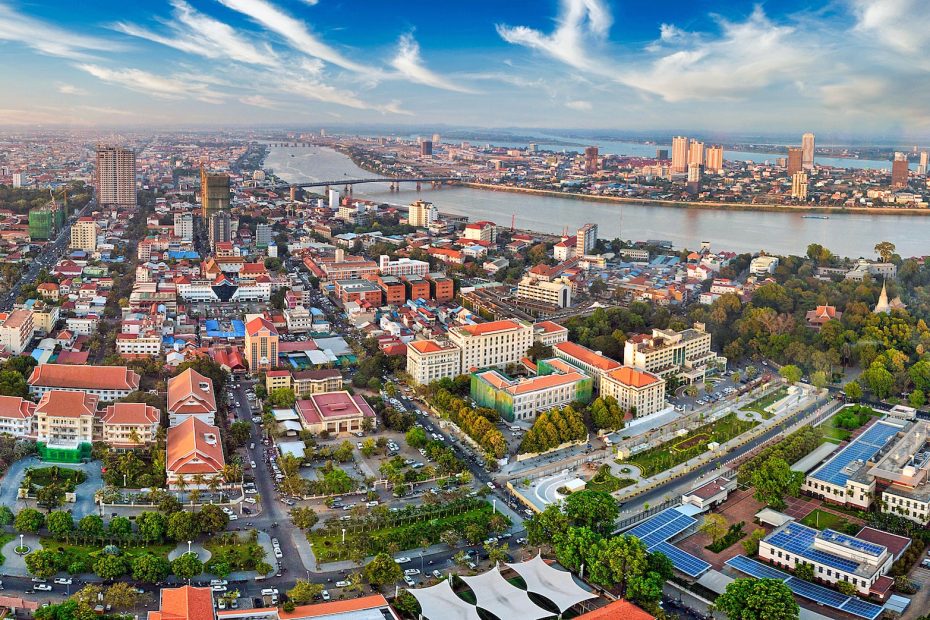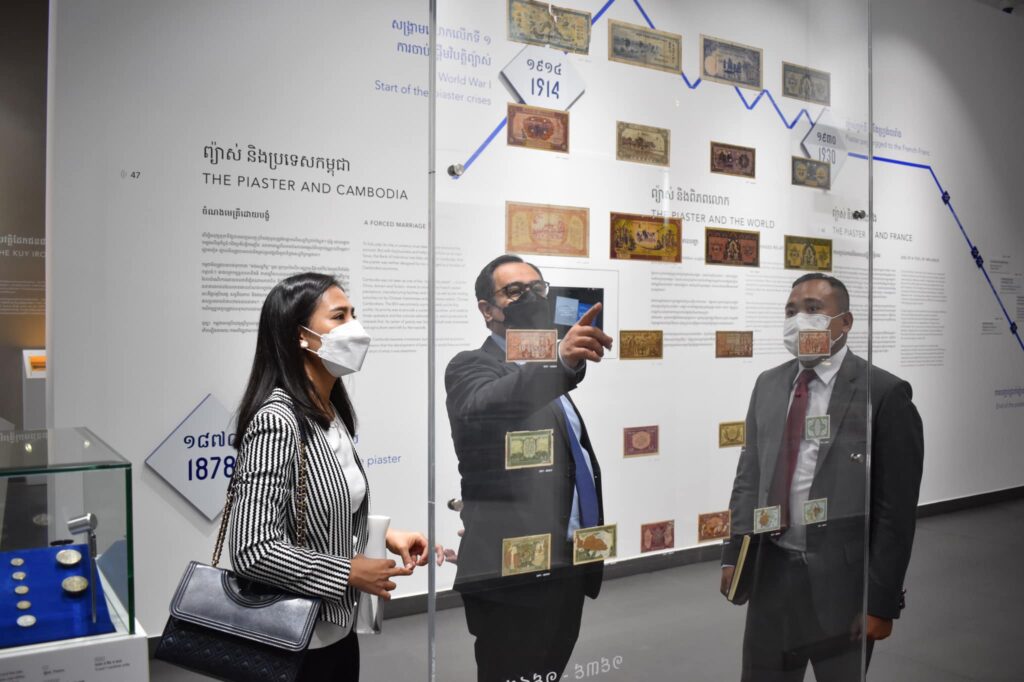Phnom Penh’s cultural and historical treasures weave a tapestry of Cambodia’s past and present. Each destination holds its own charm and significance, offering visitors a chance to connect with the country’s rich heritage. Whether you’re drawn to the spiritual sanctuaries, royal residences, or vibrant markets, exploring these top must-visit destinations in Phnom Penh promises an unforgettable journey through time and culture.
Let’s embark on a virtual tour of Phnom Penh’s most iconic cultural and historical destinations that every traveler should explore.
1. Wat Phnom Daun Penh: A Spiritual Oasis
At the heart of the city stands a serene hill crowned with Wat Phnom Daun Penh, a Buddhist temple steeped in legend. According to local lore, the temple’s founding dates back to the 14th century when a wealthy widow named Daun Penh discovered four Buddha statues and a sacred relic within a tree on this very hill. The temple, surrounded by lush gardens, offers a peaceful escape from the bustling city streets. As you climb the steps to the temple, take in the panoramic views of the city and marvel at the intricate sculptures and vibrant paintings that adorn the pagoda.
2. Royal Palace: A Glimpse into Cambodia’s Royalty
A short stroll from Wat Phnom leads to the resplendent Royal Palace, a complex that has served as the residence of Cambodian monarchs for over a century. The extravagant architecture, characterized by intricate Khmer design, is a testament to the country’s artistic prowess. Visitors can explore the Silver Pagoda, known for its exquisite silver floor tiles and the dazzling Emerald Buddha, made from a single piece of jade. The surrounding gardens and reflecting pools add to the grandeur of this historical site.
3. Wat Langka: A Center for Learning and Meditation
For those seeking a quieter and more contemplative experience, Wat Langka offers an escape from the city’s hustle and bustle. Founded in the 15th century as a place of learning, the temple boasts a rich history as a center for education and meditation. Its tranquil atmosphere, shaded by ancient trees, is ideal for visitors seeking spiritual reflection. The central pagoda houses a beautiful Buddha statue and intricately painted frescoes that tell stories from Buddhist scriptures.
4. National Museum of Cambodia: Preserving the Past
To delve deeper into Cambodia’s history and art, a visit to the National Museum of Cambodia is essential. This elegant ochre-colored building showcases a remarkable collection of Khmer sculptures, ceramics, and artifacts dating back to different periods of Cambodian history. The museum’s exhibits provide insight into the artistic evolution and cultural heritage of the Khmer civilization, making it a must-visit destination for history enthusiasts.
Let’s Discover Best Khmer Restaurants In Phnom Penh, Cambodia
5. Central Market: Where Tradition Meets Commerce
No exploration of Phnom Penh’s culture is complete without a visit to the Central Market (Phsar Thmei). Housed under a stunning art deco dome, this bustling market offers a glimpse into the daily lives of locals and an opportunity to shop for traditional Cambodian textiles, jewelry, souvenirs, and fresh produce. The architecture itself is a blend of French colonial and Khmer styles, reflecting the city’s historical influences.
6. Silver Pagoda: A Jewel in Cambodia’s Spiritual Landscape
Located within the Royal Palace complex, the Silver Pagoda, also known as Wat Preah Keo Morokat, is a radiant gem in the heart of Phnom Penh. Its name is derived from the 5,329 silver tiles that cover the temple’s floor, creating a shimmering surface. Within its sacred walls, visitors can marvel at an array of precious statues and artifacts, including a life-sized gold Buddha studded with diamonds. The Silver Pagoda is not only a testament to Cambodia’s devotion to Buddhism but also a repository of cultural treasures that capture the country’s deep-rooted spirituality.
7. Independence Monument: A Symbol of Cambodia’s Freedom
Standing tall in the heart of Phnom Penh is the Independence Monument, a striking symbol of Cambodia’s struggle for independence from French colonial rule. The monument’s unique design, inspired by traditional Khmer architecture, features five tiers representing the five-pointed star on the Cambodian flag. It’s a site of commemoration and reflection, often adorned with flowers and flags during national holidays and celebrations. The surrounding gardens provide a serene space for both locals and visitors to gather and pay homage to Cambodia’s journey to freedom.
8. Statue of Sihanouk Norodom: Honoring a Visionary Leader
Amid the city’s urban landscape stands a bronze statue of Norodom Sihanouk, one of Cambodia’s most influential leaders. Sihanouk’s legacy is celebrated for his role in gaining Cambodia’s independence and his efforts to modernize the nation. The statue, located at the intersection of Norodom and Sihanouk Boulevards, serves as a tribute to his leadership and enduring impact on Cambodia’s history.
9. Tuol Sleng Genocide Museum: Remembering a Dark Past
While not an easy destination to visit, the Tuol Sleng Genocide Museum stands as a somber reminder of Cambodia’s tragic history under the Khmer Rouge regime. Once a high school, the site was transformed into Security Prison 21 (S-21), where countless innocent Cambodians were interrogated, tortured, and killed. The museum serves as a testament to the resilience of the Cambodian people and a tribute to those who suffered. It’s a place of remembrance and education, urging visitors to understand the horrors of the past to ensure a brighter future.
10. Choeung Ek Genocidal Center: Honoring the Victims
A short distance from Phnom Penh, the Choeung Ek Genocidal Center is a solemn memorial dedicated to the victims of the Khmer Rouge regime. Often referred to as the “Killing Fields,” this site was one of many where mass executions occurred. Today, the center stands as a serene and poignant space for reflection and remembrance. Visitors can see the Memorial Stupa filled with the skulls and bones of those who perished, a stark reminder of the atrocities committed during that dark period in Cambodian history.
11. Russian Market (Phsar Toul Tom Poung): A Shopper’s Paradise with Local Flair
Immerse yourself in the vibrant local culture and discover unique treasures at the Russian Market, locally known as Phsar Toul Tom Poung. This bustling marketplace is a haven for shoppers seeking everything from traditional textiles and handicrafts to modern clothing and electronics. Despite its name, the Russian Market offers a distinctly Cambodian experience, where haggling with friendly vendors is part of the adventure. Explore narrow alleys brimming with colorful stalls and uncover a world of souvenirs, fabrics, jewelry, and authentic Cambodian artistry.
12. Daughters of Cambodia Visitor Centre: Empowerment Through Artisan Craftsmanship
In the heart of Phnom Penh, the Daughters of Cambodia Visitor Centre combines social enterprise with creativity to bring about positive change. This center empowers survivors of human trafficking and exploitation by providing them with skills and support to create beautiful handmade products. The visitor center showcases these exquisite crafts while sharing the stories of the artisans who crafted them. By supporting this initiative, visitors contribute to a brighter future for these resilient women and promote ethical tourism.
13. Bassac Lane: A Bohemian Escape in Urban Phnom Penh
For those seeking a lively and artistic atmosphere, Bassac Lane offers a hip and offbeat urban experience. Tucked away from the bustling streets, this pedestrian lane is a hidden gem adorned with colorful murals, cozy cafes, and vibrant bars. It’s a perfect spot to unwind, socialize, and enjoy the local music and arts scene. Whether you’re looking for live performances, unique cocktails, or simply a place to relax, Bassac Lane invites you to experience a different side of Phnom Penh.
Conclusion
Phnom Penh is a city of contrasts, where ancient traditions meet modern innovation. These lesser-known destinations, from vibrant markets to initiatives supporting social change, offer a more intimate and authentic glimpse into the city’s diverse character. As you explore Russian Market, engage with the Daughters of Cambodia Visitor Centre, unwind at Bassac Lane, or take to the skies with Fly Phnom Penh, you’ll discover a tapestry of experiences that contribute to the vibrant mosaic of this captivating Cambodian capital.



